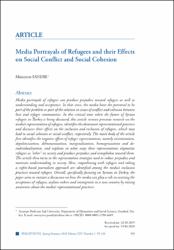| dc.contributor.author | Pandır, Müzeyyen | en_US |
| dc.date.accessioned | 2021-06-24T11:31:04Z | |
| dc.date.available | 2021-06-24T11:31:04Z | |
| dc.date.issued | 2020 | |
| dc.identifier.citation | Pandır, M. (2020). Media portrayals of refugees and their effects on social conflict and social cohesion. Perceptions: Journal of International Affairs, 25(1), 99-120. | en_US |
| dc.identifier.issn | 1300-8641 | |
| dc.identifier.issn | 2651-3315 | |
| dc.identifier.uri | https://hdl.handle.net/11729/3169 | |
| dc.identifier.uri | https://app.trdizin.gov.tr/makale/TkRFM05qVTRPQT09 | |
| dc.description.abstract | Media portrayals of refugees can produce prejudice toward refugees as well as understanding and acceptance. In that sense, the media have the potential to be part of the problem or part of the solution in issues of conflict and cohesion between host and refugee communities. In this critical time when the future of Syrian refugees in Turkey is being discussed, this article reviews previous research on the media’s representation of refugees, identifies the dominant representational practices and discusses their effects on the inclusion and exclusion of refugees, which may lead to social cohesion or social conflict, respectively. The main body of the article first identifies the negative effects of refugee representations, namely victimization, depoliticization, dehumanization, marginalization, homogenization and deindividualization, and explains in what ways these representations stigmatize refugees as “other” in society and produce prejudice and xenophobia toward them. The article then turns to the representation strategies used to reduce prejudice and motivate understanding in society. Here, empathizing with refugees and taking a rights-based journalism approach are identified among the media’s inclusion practices toward refugees. Overall, specifically focusing on Syrians in Turkey, the paper aims to initiate a discussion on how the media can play a role in assisting the acceptance of refugees, asylum seekers and immigrants in a new country by raising awareness about the media’s representational practices. | en_US |
| dc.language.iso | eng | en_US |
| dc.publisher | Stratejik Araştırmalar Merkezi Başkanlığı, T.C Dışişleri Bakanlığı | en_US |
| dc.rights | info:eu-repo/semantics/openAccess | en_US |
| dc.rights | Attribution-NonCommercial-NoDerivs 3.0 United States | * |
| dc.rights.uri | http://creativecommons.org/licenses/by-nc-nd/3.0/us/ | * |
| dc.subject | Inclusion and exclusion | en_US |
| dc.subject | Media | en_US |
| dc.subject | Refugees | en_US |
| dc.subject | Representation | en_US |
| dc.subject | Social cohesion | en_US |
| dc.subject | Syrians | en_US |
| dc.title | Media portrayals of refugees and their effects on social conflict and social cohesion | en_US |
| dc.type | article | en_US |
| dc.description.version | Publisher's Version | en_US |
| dc.relation.journal | Perceptions: Journal of International Affairs | en_US |
| dc.contributor.department | Işık Üniversitesi, Fen Edebiyat Fakültesi, İnsan ve Toplum Bilimleri Bölümü | en_US |
| dc.contributor.department | Işık University, Faculty of Arts and Sciences, Department of Humanities and Social Sciences | en_US |
| dc.contributor.authorID | 0000-0003-1590-4689 | |
| dc.identifier.volume | 25 | en_US |
| dc.identifier.issue | 1 | |
| dc.identifier.startpage | 99 | |
| dc.identifier.endpage | 120 | |
| dc.peerreviewed | Yes | en_US |
| dc.publicationstatus | Published | en_US |
| dc.relation.publicationcategory | Makale - Ulusal Hakemli Dergi - Kurum Öğretim Elemanı | en_US |
| dc.contributor.institutionauthor | Pandır, Müzeyyen | en_US |




















